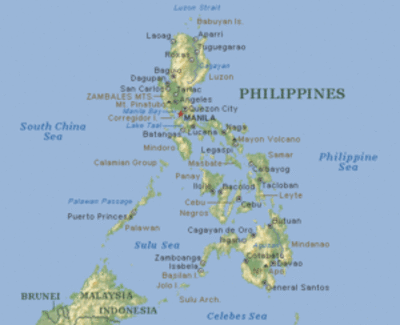Returning to Leyte Landing, For the First Time
by B.J. Stolbov
Battle of Leyte Gulf, USS Princeton via Wikipedia commons.If you were to go across the Pacific Ocean by ship to the southern Philippines, Leyte would be the one of the first places that you could land. In October 1944, General Douglas MacArthur and the U.S. Army knew that, the Imperial Japanese Army and General Tomoyuki Yamashita knew that, and Captain Morton S. Stolbov, D.D.S., a U.S. Army Field Surgeon, also knew that.
Leyte Gulf is the biggest gulf in the southern Philippines that opens into the Pacific Ocean. Ships, hundreds of ships steamed in, then turned north into San Pedro Bay, then turned west, toward the town of Palo, then finally turned onto a long expanse of beach that the U.S. Army called Red Beach. Here, on October 20, 1944, the largest landing in the Pacific Theater took place.
One of the first to come ashore that morning was Captain Morton S. Stolbov. He didn’t have to be there. He didn’t have to go to war. He had graduated from Temple University Dental School in Philadelphia, Pennsylvania, in 1939. He returned to his parents and his home, Tamaqua, Pennsylvania, a small town in the coal regions, and opened a dental practice. He was doing well in his hometown, his career, and his life. A short man with thick glasses and a receding hairline, he was already 27 years old, too old to be drafted, when the Japanese attacked Pearl Harbor on December 7, 1941. But, in one of the few spontaneous acts of his life, he volunteered to go to war.
A Doctor of Dental Surgery, Dr. Stolbov was assigned as an Army Field Surgeon. He was trained in treating combat wounds, specializing in wounds of the mouth and head. While completing his training at Camp Ellis, near Peoria, Illinois, in 1942, he met a pretty, sociable, United Service Organization (USO) singer, Mae Kriegsfeld. After knowing Mae for less than 10 days, in what was by far the most spontaneous act of his life, he asked her to marry him on Saturday, she said “Yes” on Sunday, and he shipped out on Monday.
He arrived in New Guinea, ready to go to war and, almost immediately, came down with malaria. Yet, he continued his training for combat duty. When he recovered, he was sent into combat in central New Guinea. He worked in a field hospital at the front, under heavy enemy gunfire, as the U.S. Army fought its way north, until the battle of New Guinea was won. In the fall of 1944, the Sixth Army, and the 37th Field Hospital, and Capt. Morton S. Stolbov prepared themselves for the invasion of the Philippines.
Lyete Landing MemorialThe wind blows hard off the water of Leyte Gulf. Leyte Gulf is gray and rough. Leyte Landing is a rocky, gravelly beach. The land after the beach is flat and smooth. Up from the beach is the Leyte Landing Memorial. Here stands the “Water Walkers,” the larger-than-life-sized bronze statues of General MacArthur and Sergio Osmeña, the Philippine President-in-Exile, and their staffs, wading ashore. Here, on October 20, 1944, General MacArthur fulfilled his promise to the Philippine people to return.
The Memorial and the Statues are a quiet place, in what must be a stark contrast to the sweat, blood, and chaos of the soldiers who fought for their lives for a foothold, for many hours, a few hundred yards below, before MacArthur and the others came ashore.
(It was in the mountains of Leyte where the long battles were fought for many weeks and months, where many were killed and wounded, where Dr. Stolbov worked and survived. “Fatigue would really get to you. Because, it was a crazy war, the Americans would fight in the daylight, and the Japanese would fight at night, so it was a 24-hour war. The Japanese used to hide-out, they were retreating, they used to hide, and then the action, it was just a matter of keeping you occupied, and keeping you annoyed by the sniper action that you got at night all the time,” Dr. Stolbov would later explain.)
Now, I am sixty-one years old, serving in the U.S. Peace Corps, and a volunteer. When I was assigned to the Philippines, I knew that I wanted to come to this place. Almost sixty-eight years after Captain Morton S. Stolbov landed at Leyte Landing, I have returned.
Today, I am standing on the same beach where Morton Stolbov, my father, who was not yet my father, but a young, engaged, brave volunteer, landed so many years ago. I am standing in my father’s footsteps. My feet are wet in the choppy surf. And my eyes are wet as I turn and I look out from this beach east into the wide-open Pacific Ocean, searching for some long-ago connection with my father, looking for some long-lost spirit of my father, who died in 2005.
Today, Dad, I feel that I have completed some long essential circle in our lives. Thank you, Dad. Rest in peace.
Morton and Bruce Stolbov, 2005.B.J. Stolbov is a novelist, poet, essayist, short story writer, and travel writer. He is the author of the novel “Last Fall” (Doubleday) and the book of poetry “Walks” (Foot Print Press). He is a teacher of T’ai Chi and Chi Gong. Currently, he is teaching high school English to Ilocano-speaking students in the Philippines.






